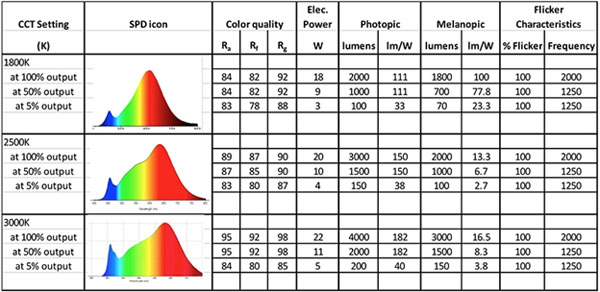In his August “LED Watch” column in LD+A, James Brodrick discusses how accurate product comparisons for color tunable LED luminaires can a challenge for specifiers. An excerpt follows:
The appearance on the market of an increasing number of color-tunable LED lighting products underscores the innovative, game-changing potential of solid-state lighting. But it also illustrates some of the complexities that can come into play when new wrinkles are added to any technology. The wide variety of approaches different manufacturers use to achieve color tuning creates challenges for testing, controlling and specifying such products. Specifying them rests on the ability to make accurate product comparisons, but reporting performance values for color-tunable products is much more complicated than it is for other LED product categories. Indeed, the range of possibilities makes it more challenging to measure and communicate performance, and the standardized test procedures for these products only give you a snapshot of their performance, not the full range of their capabilities.
A U.S. Department of Energy study highlights a number of issues that make specifying these products particularly challenging. What follows are some guidance for manufacturers and specifiers, based on this study and other sources.
CUT-SHEET INFORMATION
One problem is that relevant information may be missing from the product cut sheet. The following list outlines some of the information specifiers need but that’s not always provided:
- Kind of color change. Is it white-tunable, dim-to-warm, full-color-tunable, or some combination of the three?
- Color module. Since multiple manufacturers may use the same module, this may be a way to specify multiple manufacturer names for a luminaire type but get exactly the same color capabilities with the same or similar controls. If the luminaire uses a proprietary array or module, call it “proprietary.”
- Control protocol options. Does the product use a proprietary control system, or wired controls (e.g., 0-10V, DMX512, DALI), or wireless control protocols (e.g., Zigbee, Wi-Fi, Bluetooth)?
- Driver options. Which option comes standard, and if there are other options, how is the catalog number modified to reflect the different driver? Does the expected input from the dimmer to the driver follow a linear, square-law, or power-law curve; and how does the driver respond to that input in the way it delivers light output?
- How to specify a complete functional system. Information needed includes compatible user interface, complete system wiring diagram, and any needed black-box control devices, housings, cables, connectors, etc. If a black-box device is needed between control and driver, what is the maximum and minimum number of LED drivers/luminaires that each device can control?
- Cable type, connectors and related requirements. Between user interface and black-box device and between black-box device and luminaire, is the wiring for standard or low-voltage power, how many wires of what wire gauge are needed, what is the maximum run length, and are there any further requirements for the cable runs?
- How to order the product. E.g., through an electrical distributor, local representative, or online store, or directly from the manufacturer?
- Power use. What are the minimum and maximum watts at undimmed output, and are they different at different color settings?
- Dimming performance for the most common driver/control combinations. What is the minimum dimming level? Does the product dim to off, or does it drop to a specific output level and then to off?
PERFORMANCE TESTING AND REPORTING
Guidelines for performance testing and reporting of color-tunable luminaires have not yet been established by the industry. In the interim, manufacturers may consider providing the following data for the minimum, mid-range and maximum CCT settings:
- For luminaires with more than three LED primaries, testing at five to seven points along their “white” range, in order to provide specifiers with higher-precision spectral and light-output performance data.
- Candela distribution data file in .ies format, plus graphical candela curve for at-a-glance light-distribution information. Alternately, provide a single candela distribution file, with multipliers for different combinations of intensity and color setting.
- For white-tunable and dim-to-warm products, graphical SPD plots and electronic color files (.spdx) for at least the minimum, maximum, and mid-range CCT settings. Provide complete spectral power data file in no more than 5-nm increments between 380 and 760 nm. Color metrics such as CCT, Duv, CRI (Ra), Rf, Rg, and R9 can be derived from these data.
- For circadian health applications, summary data of melanopic and photopic lumens and efficacy.
- Percent flicker and flicker frequency at maximum, minimum, and mid-range output.

Avoiding the problems listed above will result in more satisfied specifiers, clients, and users of color-tunable LED lighting products. It’s incumbent on the manufacturer to provide product literature and specification support that makes the process easier. For more information on color-tunable LED lighting products, visit https://energy.gov/eere/ssl/led-color-tunable-products.
August 2016


